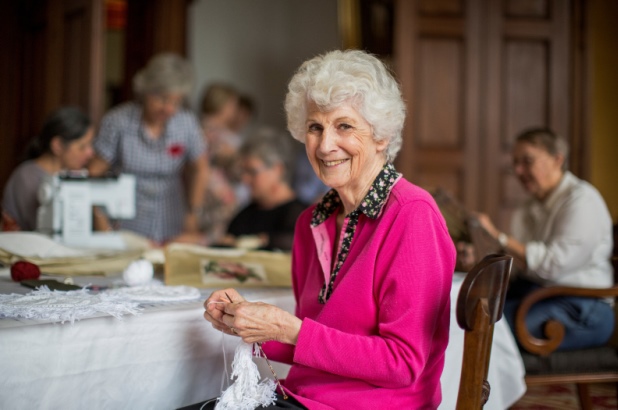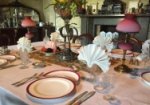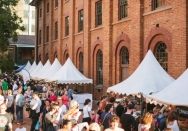This week at Elizabeth Farm we thanked our dedicated Soft Furnishings Group for all their efforts: creating curtains, bed-hangings and covers, table cloths, covers and runners – and so many doilies for the dining room!
When we furnish our house museums, soft furnishings are often the most difficult to source or reproduce. We draw on period texts, documents and illustrations for guidance, and then whenever possible on the skills (and patience) of our volunteers.
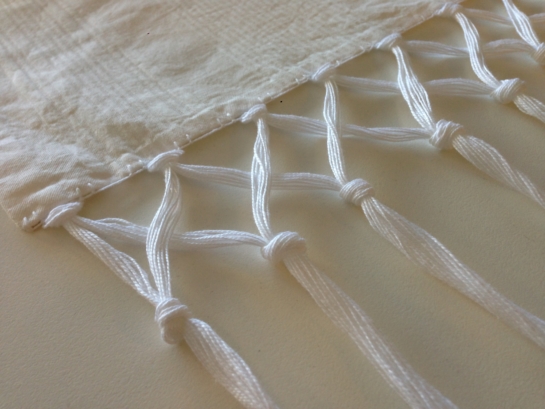
The eagle-eyed will have spotted that in pictures of dessert settings in this blog the fringed edges of doilies can be seen poking out from under plates, bowls, tureens and comports.
You get a doily, and you get a doily, everyone gets a doily (literally)!
The doily is one of those iconic elements of the 19th and 20th century century interior. It’s an item however that evolved in appearance and use through the 18th and 19th centuries. Samuel Johnson’s definition (Dictionary of the English Language, 1755) isn’t terribly helpful: “DO’ILY: a species [type] of woolen stuff, so called I suppose, from the name of the first maker.” When Elizabeth Bay House and Elizabeth Farm were opened to the public, Elizabeth (‘Lizzie’) Wright reproduced an extraordinary amount of soft furnishings – curtains, valances, bed-hangings and case covers. In the book she co-wrote with James Broadbent , Soft Furnishings 1830-1930 (Historic Houses Trust of NSW, 1995) is this discussion of the definition and origins of the doily:
A doyley was originally a dessert napkin or towel, made first of a light woollen fabric, but later woven in cotton and linen… Its name has been attributed to a late 17th century English mercer [merchant], Mr Doily, but the ‘Dictionary of Needlework’ suggested it was “derived from the Dutch ‘dwaele’, signifying a towel.” According to ‘The Workwoman’s Guide’ doyleys were “six nails square” and “generally fringed.” Catherine Beecher in 1845 elaborated on their use in American dining rooms at dessert “when fruit is offered.. to prevent a person from staining a nice handkerchief or permitting the fruit-juice to dry on the fingers.”
(A ‘nail’ as a unit of fabric measurement is 1/16th of a yard, or 21⁄4 inches – roughly 5.7 cm.) It then made the move from being a fancy version of a napkin, to an item of table display:
Knitted doyleys prior to the 1840s were firm, and closely textured, perhaps resembling the woolen fabric from which they took their name, but also similar to fine huckaback towelling. During the 1840s they became considerably finer and the patterns fancier, the round doyley supplanting the square. Presumably the use of the doily changed with the texture and shape, which was now better adapted to sitting under, or upon a plate to display the fruit…
Wright and Broadbent, Soft Furnishings 1830-1930 (Historic Houses Trust of NSW, 1995)
From there they made their way to the lady’s dressing table, and then throughout the house. That great curatorial resource, The Footmans Guide (1826), mentions doilys in the dessert course:
The cloth being removed and the table wiped down, put on the dessert…. place a d’oyley and two wine glasses to each person at table….
A favorite commentator of mine, Prince Puckler-Muskau, noted their use on English (a generic word used to mean ‘British’) tables, and names them ‘fringed napkins’:
The table cloth is… removed: under it, at the best tables, is a finer, upon which the dessert is set. At inferior ones, it is placed upon the bare polished table. It consists of all sorts of hot-house fruits, which are here of the finest quality, Indian and native preserves, stomachic gingers, comfitures and the like. Clean glasses are set before every guest, and, with the dessert plates and knives and forks, small fringed napkins are laid.
Tour in England, Ireland, and France: in the years 1826, 1827, 1828, and 1829. With remarks on the manners and customs of the inhabitants, and anecdotes of distinguished public characters. in a series of letters by a German prince. (1833)
In both cases it is not totally clear whether it is a doily used under the plate, or as a literal, albeit decoratively fringed napkin. In these views, you can see them on the table at Elizabeth Farm (as made by Marjory Bennett) and at Vaucluse House (made by Lizzie Wright):
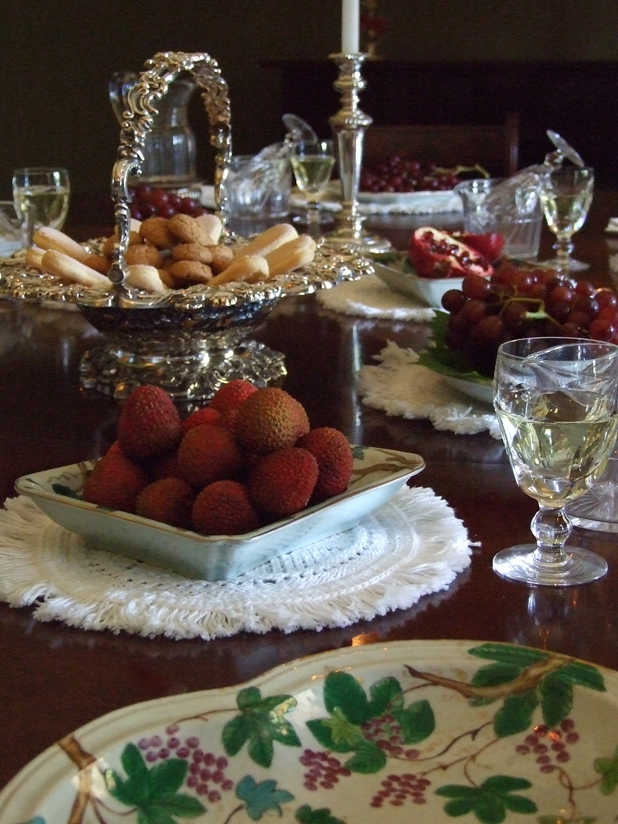
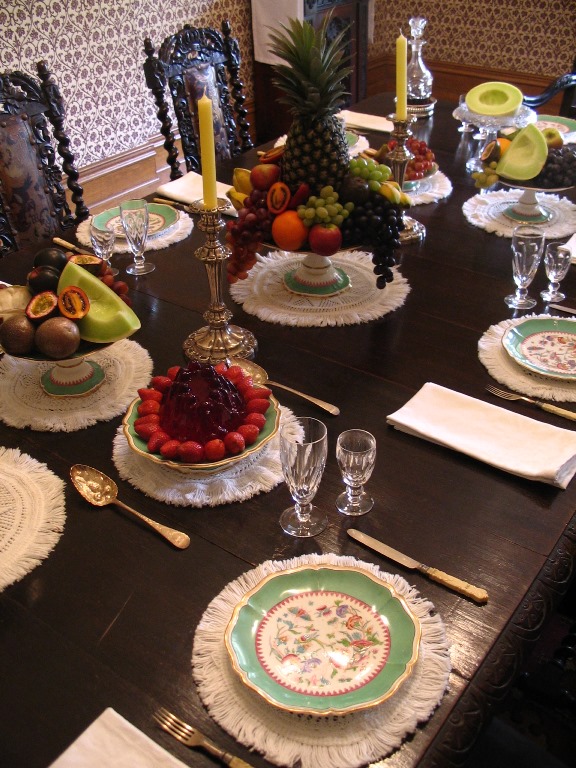
14 meters of knitted fringe
This past year at Elizabeth Farm the Soft Furnishings Group has produced embroidered curtains, fringed muslin curtains for the drawing room, fringed runners, and a fantastic new set of lightweight muslin bed-hangings – edged with 14 meters of continuous hand-knitted fringe. They’d already produced a stack of 16 knitted doilys for use on the dining table – and these have also been pressed into service throughout the house under vases, candlesticks and glass shades. The challenge was taking a 19th century pattern, such as from Cornelia Mee’s A manual of knitting, netting and crochet (1845), and getting it to work through trial and error.
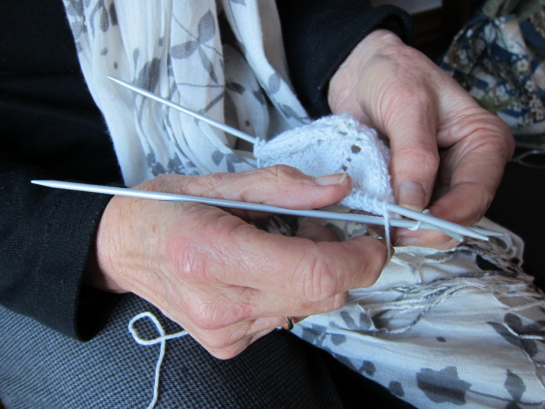
To thank our volunteers we had a morning tea at Elizabeth Farm last week. The table setting was inspired by period texts, particularly a long letter sent to Maria Macarthur from her godmother ‘Mrs E’ in 1812 (published as Advice to a Young Lady in the Colonies, Greenhouse Publishing, Collingwood, 1979), and The Footmans Guide (1826). At opposing ends were the coffee and tea, surrounded by arcs of cups, while the sweet cakes and scones were placed symmetrically. The grapes were, of course, snipped into individual bunches.

D’oyley, doyly or doily?
So how exactly is it spelled? While several variations are in common use – doyley, doiley & doily – and all are correct, as an institution Sydney Living Museums uses the Macquarie Dictionary’s spelling. Its definition is – Doily (pl. doilies): a small ornamental mat, as of embroidery or lace, paper or plastic, often placed under cakes, sandwiches, etc., on a plate. The materials are a guide as to where they will usually be placed: fabric doilies will be placed under the plate, while paper or plastic will be between the plate and the foodstuff.

Spelling aside, if you were to turn to the person next to you and ask what a ‘doily’ was, you’d quickly see that the name has come to be applied to all number of knitted, macramed, crocheted or lacework items on which objects are displayed, and which protect a wooden surface from being scratched. Lamp mats, for example, would now typically be identified as a ‘doily’, as would an antimacassar – despite that being a very distinct object placed on a chair back so that a man’s hair pomade wouldn’t stain the fabric.
…and D’oyly Carte?
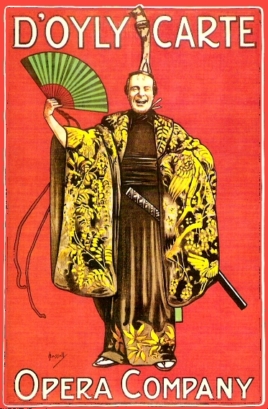
…Has absolutely nothing to do with doilys but has given rise to no end of jokes that do. Richard D’Oyly Carte founded the Savoy Theater in London, and in 1875 brought together Gilbert & Sullivan. It does recall Johnson’s note that the idea that the word stemmed from an actual name.
